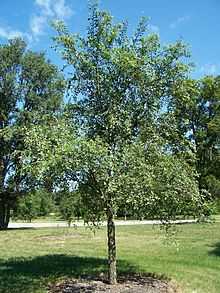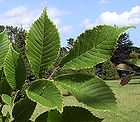Ulmus chenmoui
| Ulmus chenmoui | |
|---|---|
 | |
| Chenmou Elm at Morton Arboretum | |
| Conservation status | |
| Scientific classification | |
| Kingdom: | Plantae |
| (unranked): | Angiosperms |
| (unranked): | Eudicots |
| (unranked): | Rosids |
| Order: | Rosales |
| Family: | Ulmaceae |
| Genus: | Ulmus |
| Species: | U. chenmoui |
| Binomial name | |
| Ulmus chenmoui W.C.Cheng | |
Ulmus chenmoui W. C. Cheng, commonly known as the Chenmou, or Langya Mountain, Elm, is a small deciduous tree from the more temperate provinces of Anhui and Jiangsu in eastern China, where it is found at elevations below 200 m on the Langya Shan and Baohua Shan mountains.[1][2]
Description

Although the tree can grow to a height of < 20 m, the slender trunk rarely exceeds 0.5 m d.b.h.; the bark exfoliates in irregular flakes. The wing-less twigs bear comparatively large obovate to oblong leaves < 18 cm in length , with doubly serrate margins and caudate to acuminate apices. Leaves of specimens grown in the USA developed a thick pubescence, giving them a greyish appearance, but this has not been reciprocated in English - grown trees. The perfect wind-pollinated apetalous flowers are produced on second-year shoots in March; the samarae are obovate < 25 mm long by 17 mm wide and ripen in April.
Pests and diseases
U. chenmoui has a very high resistance to Dutch elm disease, on a par with Ulmus pumila,[3] and is eschewed by the Elm Leaf Beetle Xanthogaleruca luteola, but has a moderate susceptibility to Elm Yellows [4] .[5]
Cultivation
The tree is rare in cultivation in the West, but is (2009) under evaluation at the Morton Arboretum in North America, and in Italy.[6] It also featured in elm trials conducted by the Institut National de la Recherche Agronomique (INRA) on gravelly soils in the Bois de Vincennes, Paris, but most specimens were killed by drought. Trees grown from seed obtained from the hills near Chu-hsien gave a more encouraging performance in the Netherlands where rather surprisingly, for a species accustomed to milder climes, they survived the cold winter of 1980/81 completely unscathed when temperatures fell to -19° C [3] The tree is not currently known to be in commerce beyond the USA.
Notable trees
The UK TROBI Champion grows at the Sir Harold Hillier Gardens near Romsey, Hampshire; planted in 1994, it measured 8 m high by 22 cm d.b.h. in 2010. [7]
Cultivars & hybrid cultivars
There are no known cultivars of this taxon. U. chenmoui has been hybridized with the Dutch clone '405' (U. × hollandica × U. minor) by the Istituto per la Protezione delle Piante (IPP), Florence, to create 'Morfeo', a robust, fast-growing tree patented and released to commerce in 2011. IPP also hybridized U. chenmoui with the early Dutch hybrid cultivar 'Groeneveld', identifying the new cultivar as FL '522', however there are no plans to release it to commerce.
Accessions
North America
- Chicago Botanic Garden, Glencoe, Illinois. Planted in West Collections Area. No acc. details.
- Denver Botanic Gardens. No acc. details.
- Morton Arboretum, Illinois. Acc. nos. 47-95, 51-96, 105-98
- U S National Arboretum , Washington, D.C., USA. Acc. nos. 68979, 76220, 76221, 76222, 68032.
Europe
- Grange Farm Arboretum, Sutton St James, Spalding, Lincolnshire, UK. Acc. no. 508
- Sir Harold Hillier Gardens, UK. Acc. no. 1994:0328, 3 specimens planted 1993 in the Crookhill Field. Measured in 2005, all were between 5 m and 7 m tall.
- Verrières le Buisson Arboretum (private), Paris, France. Details not known
Nurseries
- North America
- Sunshine Nursery , Clinton, Oklahoma.
- Urban Forest Nursery, Mount Vernon, Washington.
References
- ↑ Fu, L. & Jin J. (eds). (1992). China Red Data Book. Rare and endangered plants. Vol. 1. Science Press, Beijing.
- ↑ Fu, L., Xin, Y. & Whittemore, A. (2002). Ulmaceae, in Wu, Z. & Raven, P. (eds) Flora of China, Vol. 5 (Ulmaceae through Basellaceae). Science Press, Beijing, and Missouri Botanical Garden Press, St. Louis, USA.
- ↑ 3.0 3.1 Heybroek, H. M. (1981). The Japanese elm species and their value for the Dutch elm breeding programme. Proceedings of the Dutch Elm Disease symposium and workshop, October 5–9, Winnipeg, Manitoba, 78 - 90.
- ↑ Mittempergher, L, & Porta, N. la, (1991). Hybridization studies in the Eurasian species of elm (Ulmus spp.). Silvae Genetica 40, 237-243.
- ↑ Sfalanga, A, Martini, M., Surico, G., & Bertaccini, A. (2002). Involvement of phytoplasmas in a decline of Ulmus chenmoui in Central Italy. Forest Pathology, Vol. 32, Issue 4-5, 265-275, August 2002.
- ↑ Mittempergher, L. & Santini, A. (2004) The history of elm breeding. Investigacion agraria: Sistemas y recursos forestales 13(1): 161-177 (2004)
- ↑ Johnson, O. (2011). Champion Trees of Britain & Ireland, p. 168. Kew Publishing, Kew, London. ISBN 9781842464526.
